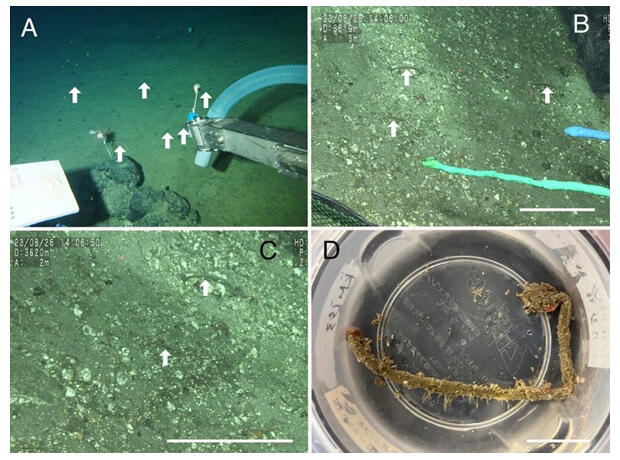The deep-sea accounts for the majority of the ocean, which covers about 70% of the earth's surface. The diversity and ecology of organisms occurring there remain shrouded in mystery because of the harsh environmental conditions of the deep sea, such as high pressure, low temperature, and low nutrition. In particular, detailed studies on the ecology and behavior of benthic organisms living on the deep-sea floor are limited, and their lifestyles remain largely unknown.
Lecturer Naoto Jimi at the Sugashima Marine Biological Laboratory, Graduate School of Science, Nagoya University, boarded the manned research submersible "Shinkai 6500" of the Japan Agency for Marine-Earth Science and Technology (JAMSTEC) to conduct a direct deep-sea survey. He discovered the new polychaete species "Melinnopsis shinkaiae [Japanese name: Takeuma-kazari-gokai]." Its Japanese name was given on account of its unique ecology that it constructs a vertical tube on the deep-sea floor of the Daiichi-Kashima Seamount (Northwest Pacific Ocean) at a depth of 3623 m and inhabits its upper end, looking as if the marine annelid worm wears "Takeuma," which refers to Japanese stilts.
Nest-building polychaete annelids generally live in the mud and never reach the seafloor surface. The ecology of this species is unique in that it constructs a vertical tube and inhabits its upper end, representing its specialized life strategy. In the 20th century, bottom trawling represented the main method for organism surveys in the deep sea. Thus, it was impossible to see how the organisms actually lived at the bottom of the ocean. After the advent of submersibles, it became possible to reveal the ecology of organisms in such marine areas where humans cannot go directly.
The discovery in this study provides clues to a better understanding of the diverse lifestyles and ecosystems of deep-sea organisms and the results were published in Plankton and Benthos Research, the joint journal of the Plankton Society of Japan and the Japanese Association of Benthology.

Provided by Nagoya University
The discovery in this study was made possible by the submersible Shinkai 6500, which can accommodate researchers. Because the vessel can be used for observation and collecting samples on-site, it can provide detailed information and new insights into the ecology of organisms beyond what can be obtained with remotely operated submersible systems. Investment in such research infrastructure is essential to support Japan's unique and original research.
Journal Information
Publication: Plankton and Benthos Research
Title: Taxonomy and ecological insights into Melinnopsis shinkaiae sp. nov., a polychaete with a vertical tube from the Daiichi-Kashima seamount (Northwest Pacific)
DOI: 10.3800/pbr.20.29
This article has been translated by JST with permission from The Science News Ltd. (https://sci-news.co.jp/). Unauthorized reproduction of the article and photographs is prohibited.




